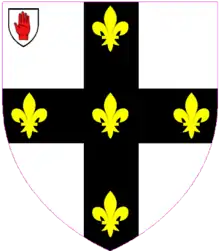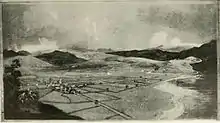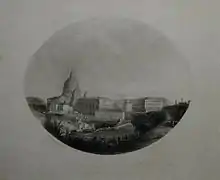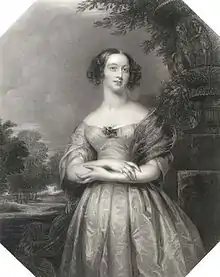Sir Digby Neave, 3rd Baronet
Sir Richard Digby Neave, 3rd Baronet (1793–1868), usually known as Digby Neave, was an English artist and author.

Early life
He was the eldest son of Sir Thomas Neave, 2nd Baronet, and brother of Sheffield Neave, and was educated at St Mary's Hall, Oxford, graduating in 1815.[1][2] He later described Edward Penrhyn as a travelling companion of the years 1817–8.[3]
Neave became Steward of the Liberty of Havering-atte-Bower in 1821.[4]
Railway director
Related by marriage to Abel Rous Dottin—Neave's father-in-law was Dottin's brother-in-law—he attended the initial meeting for the London and Greenwich Railway in October 1831. It took place in Dottin's house at 31 Argyle Street, London.[5][6] Neave became one of the railway company's directors, resigning on 26 November 1836.[7] He was then involved also, as of 1837, in the Dover Railway Company and New Gravesend Railway Company.[8]
Poor Law administrator
Neave acted as the first Assistant Poor Law Commissioner, in the Chester area, from January 1836. He was then described as a Justice of the Peace, of Havering atte Bower, Essex.[9][10][11] He owed his appointment to the recommendation of "E. Penhryn", writing to John Shaw-Lefevre. This person has been identified as the future Edward Douglas-Pennant, 1st Baron Penrhyn, but possibly was his friend Edward Penhryn, a barrister.[12] Another recommendation was from Sir Charles Trevelyan, a cousin, who let it be known that the appointment would please him.[13]
As mentor, Neave had Edward Gulson. They had a meeting in February 1836 at Clumber, with Henry Pelham-Clinton, 4th Duke of Newcastle. Another meeting to deal with Nottinghamshire Poor Law union issues, in the context of local politics and personalities, was with Robert Lowe at Bingham.[14]
Edwin Chadwick sought material with which to advocate against the Cheshire Constabulary, set up in 1829, and Neave supplied it.[15] The 1837 general election caused local resistance in Cheshire to poor law reform, which Neave characterised as "backsliding".[16] In implementing the Poor Law Amendment Act 1834, he failed to reform the Chester workhouse, which continued on the old basis to the 1860s.[17]

Friendship with John Constable
Neave was a friend of John Constable, visiting his London studio on 21 May 1819. In 1825 Constable painted portraits of Neave and his brother Sheffield.[18] In the same year, Neave became godfather to Constable's daughter Emily.[19] Constable stayed with him at Epsom;[20] this was at Pitt Place, which at that date, 1831, was leased by Neave from Rowland Stephenson. He and family members later bought it at auction, in 1840.[21]
Later life
A book from 1841 described Pitt Place as Neave's seat.[22] He became the third baronet, on his father's death in 1848. He later resided at Dagnam Park, Romford, Essex.[23] In 1861 he was elected a member of the Royal Geographical Society.[24]
Works


Neave was a landscape painter, and exhibited at the Royal Academy A Scene in the New Forest.[25] Two of his landscapes were engraved by David Lucas.[26]
Four Days in Connemara (1852), a post-Irish Famine travelogue by Neave, was called "more polemical than topographical" by The Athenaeum.[27] It took an interest in workhouses and places of correction.[28] Four Days also expressed great anxiety over the impending Irish elections of Autumn 1852, which saw a return of a great many Irish MPs from throughout the country intent on working together to reform Ireland's landholding policies (see Charles Gavan Duffy The League of North and South: An Episode of Irish History, 1850-1854).
Family

Neave married Mary Arundell, daughter of James Everard Arundell, 9th Baron Arundell of Wardour (died 29 August 1849).[29][30] They had six sons and five daughters:[31]
- Arundell Neave, 4th Baronet, married Gwyn Gertrude Hughes, daughter of William Hughes, 1st Baron Dinorben.[31] Their son Thomas Lewis Hughes Neave, 5th Baronet was a major landowner, holding nearly 10,000 acres in England and Wales.[32]
- Edward Digby (1830–1858), Bombay Civil Service.[31]
- Kenelm (d. 1861), Bombay Army.[31]
- Wyndham (d. 1858), 71st Highlanders, died in action in Morar, Gwalior on 16 June during the Central Indian campaign of 1858.[31][33]
- Ednowain Reginald, graduated B.A. 1865 at Trinity Hall, Cambridge[34]
- Augustus, died an infant.[31] (Not counted in the sons are Reginald, died an infant on 2 April 1836, and Edgar, died 10 July 1849, aged 11 months.)[35][36]
And
- Mary Blanche, married 1860 the barrister John Richard Westgarth Hale (later surname Hildyard) (died 1888)[37]
- Frances Eleanor
- Venetia, married 1860 the cleric and landowner John Whitaker Maitland[38]
- Cicely, married 1863 the barrister Wyndham Slade, son of Sir John Slade, 1st Baronet by his second wife[39][40]
- Mariquita, married 1874 Alexander George Middleton, a second cousin.[41]
|
Notes
- G. H. Townsend, ed. (1869). The Handbook of the year. p. 359.
- Edward Cave; John Nichols (1848). The Gentleman's Magazine, and Historical Chronicle. Edw. Cave, 1736-[1868]. p. 660.CS1 maint: extra punctuation (link)
- Four Days in Connemara (PDF), at p. 1
- "The History of Harold Hill and Noak Hill B Lingham". Retrieved 17 May 2017.
- Ronald Henry George Thomas (1986). London's First Railway: The London and Greenwich. B. T. Batsford Limited. p. 15. ISBN 978-0-7134-5414-7.
- The Late Elections: An Impartial Statement of All Proceedings Connected with the Progress and Result of the Late Elections. To which is Affixed a Table Noting Every Change of Members and the Closing Numbers of the Contested Polls ... Such Biographical Notices are Added as May Enable the Country to Form a Judgement of the Influence Likely to Predominate in the New House of Commons. Bensley. 1818. p. 508.
- Ronald Henry George Thomas (1986). London's First Railway: The London and Greenwich. B. T. Batsford Limited. p. 58. ISBN 978-0-7134-5414-7.
- Herapath's Railway Journal. 1837. p. 387.
- Lorie Charlesworth (16 December 2009). Welfare's Forgotten Past: A Socio-Legal History of the Poor Law. Routledge. p. 155. ISBN 978-1-135-17964-9.
- Justice of the Peace and County, Borough, Poor Law Union and Parish Law Recorder. Henry Shaw. 1838. p. 586.
- London gazette (1836). Bulletins of the campaign [compiled from the London gazette]. [Continued as] Bulletins of State intelligence, &c. p. 15.
- Anthony Brundage (1978). The Making of the new Poor law: the politics of inquiry, enactment, and implementation, 1832–1839. Rutgers University Press. p. 85. ISBN 978-0-8135-0855-9.
- Jenifer Hart, Sir Charles Trevelyan at the Treasury, The English Historical Review Vol. 75, No. 294 (Jan., 1960), pp. 92–110, at p. 98. Published by: Oxford University Press. JSTOR 558803
- Anthony Brundage (1978). The Making of the new Poor law: the politics of inquiry, enactment, and implementation, 1832–1839. Rutgers University Press. pp. 136 and 138. ISBN 978-0-8135-0855-9.
- Anthony Brundage (1988). England's "Prussian Minister": Edwin Chadwick and the Politics of Government Growth, 1832–1854. Pennsylvania State University Press. p. 66. ISBN 978-0-271-00629-1.
- Anthony Brundage (1978). The Making of the new Poor law: the politics of inquiry, enactment, and implementation, 1832–1839. Rutgers University Press. p. 168. ISBN 978-0-8135-0855-9.
- Lorie Charlesworth (16 December 2009). Welfare's Forgotten Past: A Socio-Legal History of the Poor Law. Routledge. p. 231. ISBN 978-1-135-17963-2.
- John Constable, Toward A Complete Chronology, Edited by Charles S. Rhyne, Reed College (PDF) at p. 134 and p. 208
- Constable Portraits, The Painter and his Circle (PDF) at p. 31
- John Constable (2 September 2015). Delphi Collected Works of John Constable (Illustrated). Delphi Classics. p. 504. GGKEY:2D3EBHAYY8N.
- http://www.epsomandewellhistoryexplorer.org.uk/PittPlaceFULLVer3.pdf
- Edward Wedlake Brayley; John Britton (1841). A Topographical History of Surrey. p. 368.
- The Peerage, Baronetage, and Knightage, of Great Britain and Ireland. Whittaker And Company. 1862. p. 429.
- Proceedings of the Royal Geographical Society of LondonVol. 5, No. 2 (1860–1861), p. 54. Published by: Wiley on behalf of The Royal Geographical Society (with the Institute of British Geographers) DOI: 10.2307/1798837 JSTOR 1798837
- Wood, Christopher (1981). The Dictionary of Victorian Painters. Antique Collectors Club. p. 339. ISBN 0902028723.
- "The Burlington Magazine". Internet Archive. London: The Burlington Magazine, Ltd. October 1914 – March 1915. p. 114. Retrieved 17 May 2017.
- The Athenæum: A Journal of Literature, Science, the Fine Arts, Music, and the Drama. J. Francis. 1853. p. 191.
- Glenn Hooper, The Wasteland: Writing and Resettlement in Post-Famine Ireland, The Canadian Journal of Irish Studies Vol. 23, No. 2 (Dec., 1997), pp. 55–76, at p. 73. Published by: Canadian Journal of Irish Studies. DOI: 10.2307/25515223 JSTOR 25515223
- Edmund Lodge; Anne Innes; Eliza Innes; Maria Innes (1833). The Peerage of the British Empire as at Present Existing: Arranged and Printed from the Personal Communications of the Nobility. Saunders and Otley. p. 27.
- The Gentleman's Magazine. W. Pickering. 1849. p. 441.
- Burke, Bernard (1903). Ashworth P. Burke (ed.). A Genealogical and Heraldic Dictionary of the Peerage and Baronetage, the Privy Council, Knightage and Companionage (65th ed.). London: Harrison and Sons. p. 1118.
- Bateman, John (1883). "The Great Landowners of Great Britain and Ireland; a list of all owners of three thousand acres and upwards". Internet Archive. London: Harrison. p. 329. Retrieved 17 May 2017.
- "Lord Macleod's Highlanders 1858–1874, www.coghlan.co.uk". Retrieved 18 May 2017.
- "Neave, Ednowain Reginald (NV861RE)". A Cambridge Alumni Database. University of Cambridge.
- The Gentleman's Magazine. F. Jefferies. 1836. p. 564.
- The Gentleman's Magazine. A. Dodd and A. Smith. 1849. pp. 325–.
- "Hale (post Hildyard), John Richard Westgarth (HL832JR)". A Cambridge Alumni Database. University of Cambridge.
- "Maitland, John Whitaker (MTLT850JW)". A Cambridge Alumni Database. University of Cambridge.
- Burke's Genealogical and Heraldic History of Peerage, Baronetage and Knightage. Burke's Peerage Limited. 1868. p. 1013.
- Burke, Bernard (1903). Ashworth P. Burke (ed.). A Genealogical and Heraldic Dictionary of the Peerage and Baronetage, the Privy Council, Knightage and Companionage (65th ed.). London: Harrison and Sons. p. 1395.
- Joseph Foster (1881). The Baronetage and Knightage. Nichols and Sons. p. 458.
- Burke's Peerage. 1949.
External links
| Baronetage of Great Britain | ||
|---|---|---|
| Preceded by Thomas Neave |
Baronet (of Dagnam Park) 1848–1868 |
Succeeded by Arundell Neave |